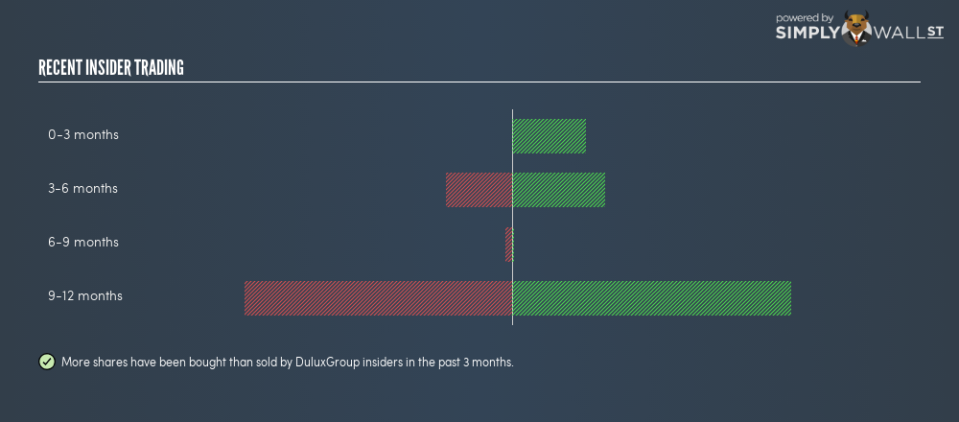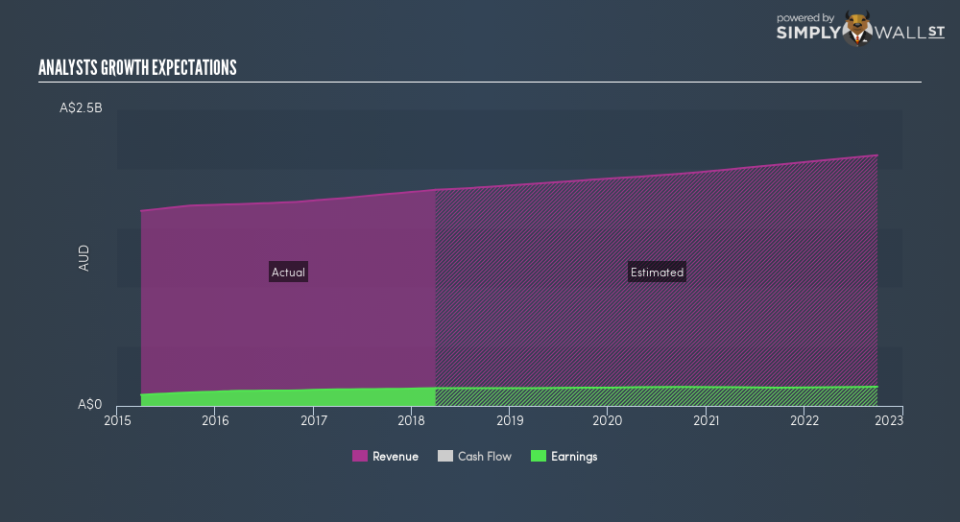Are Insiders Too Confident In DuluxGroup Limited (ASX:DLX)?

DuluxGroup Limited manufactures, markets, sells, and distributes paints, coatings, adhesives, and garden care and other building products in Australia, New Zealand, Papua New Guinea, China, South East Asia, and the United Kingdom. DuluxGroup is one of Australia’s large-cap stocks that saw some insider buying over the past three months, with insiders investing in more than 4.74 million shares during this period. A well-known argument is that insiders investing more in their own companies’ shares sends an optimistic signal. A two-decade research published in The MIT Press (1998) showed that stocks following insider buying outperformed the market by 4.5%. However, these signals may not be enough to gain conviction on whether to invest. I will be analysing whether these buying activities are supported by favourable future outlook and recent share price volatility.
See our latest analysis for DuluxGroup
Which Insiders Are Buying?
Over the past three months, more shares have been bought than sold by DuluxGroup’s’ insiders. In total, individual insiders own over 5.51 million shares in the business, which makes up around 1.44% of total shares outstanding.
. The entity that bought on the open market in the last three months was Colonial First State Asset Management (Australia) Limited. Although this is an institutional investor, rather than a company executive or board member, the insights gained from direct access to management as a large investor would make it more well-informed than the average retail investor. In this specific instance, I would classify this investor as a company insider.
Is This Consistent With Future Growth?
At first glance, analysts’ earnings expectations of 2.6% over the next three years illustrates a restrained outlook moving forward, however, insiders may be more optimistic than the market, with their net buying activity.
Probing further into annual growth rates, DuluxGroup is believed to experience a restrained level of top-line growth over the next year, which appears to fall through into the bottom line with a growth rate of1.0%. Improved cost management and revenue growth initiatives could lead to higher earnings growth in the future.
Insiders confident in the company’s potential to deliver continued growth could provide incentives to buy now.
Did Insiders Buy On Share Price Volatility?
An alternative reason for recent trades could be insiders taking advantage of the share price volatility. Volatility provides an opportunity to trade on market inefficiencies when the stock is under-priced compared to the stock’s intrinsic value.
In the past three months, DuluxGroup’s share price reached a high of A$7.95 and a low of A$7.43. This indicates a trivial share price movement, with a change of 7%.
This could indicate insider transactions are not driven by share price changes but perhaps due to their belief of the company’s growth prospects or just personal portfolio re-weighting.
Next Steps:
DuluxGroup’s insider meaningful buying activity tells us the shares are currently in favour, which is fairly consistent with earnings growth expectations, even if the low share price volatility did not warrant exploiting any mispricing. Although insider buying can be a useful prompt, following the lead of an insider, however, will never replace diligent research. I’ve put together two fundamental factors you should look at:
Financial Health: Does DuluxGroup have a healthy balance sheet? Take a look at our free balance sheet analysis with six simple checks on key factors like leverage and risk.
Other High Quality Alternatives : Are there other high quality stocks you could be holding instead of DuluxGroup? Explore our interactive list of high quality stocks to get an idea of what else is out there you may be missing!
NB: Figures in this article are calculated using data from the last twelve months, which refer to the 12-month period ending on the last date of the month the financial statement is dated. This may not be consistent with full year annual report figures.
To help readers see past the short term volatility of the financial market, we aim to bring you a long-term focused research analysis purely driven by fundamental data. Note that our analysis does not factor in the latest price-sensitive company announcements.
The author is an independent contributor and at the time of publication had no position in the stocks mentioned. For errors that warrant correction please contact the editor at editorial-team@simplywallst.com.


